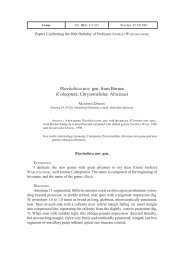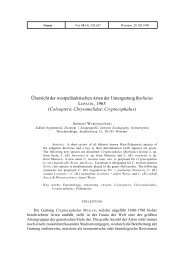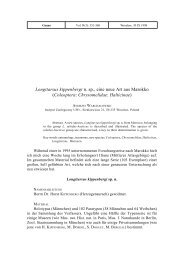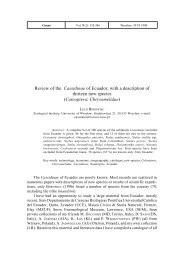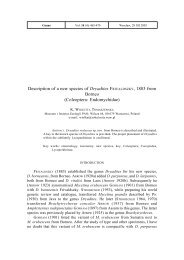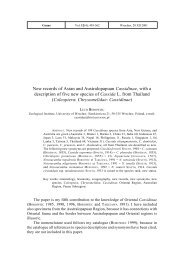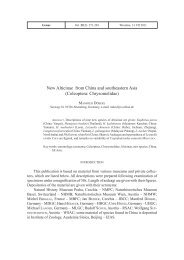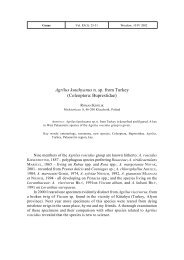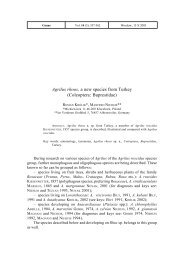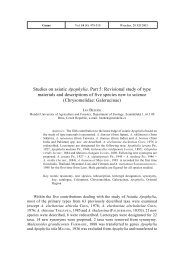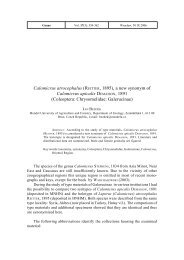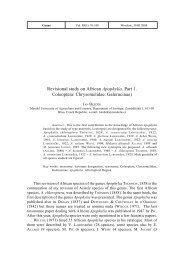A study on the genus Chrysolina MOTSCHULSKY, 1860, with a ...
A study on the genus Chrysolina MOTSCHULSKY, 1860, with a ...
A study on the genus Chrysolina MOTSCHULSKY, 1860, with a ...
Create successful ePaper yourself
Turn your PDF publications into a flip-book with our unique Google optimized e-Paper software.
A STUDY ON THE GENUS CHRYSOLINA<br />
121<br />
nal sternite is c<strong>on</strong>vex in both sexes, <strong>with</strong>out special structures; aedeagus (Fig. 6)<br />
is similar to that of Ch. (Chrysocrosita) spectabilis.<br />
MATERIAL<br />
Ch. jakowlewi: E. Siberia: Yenisei valley, 16-20.7.1902: 2 males, 1 female,<br />
P. SUSHKIN leg.; W. Sayan Mts.: Oiskoe lake, 30.6.1902: 1 female, P. SUSHKIN leg.<br />
Ch. sogdiorum: Kyrghyzstan: “Alatau Geb., E. FISCHER”: 1 male. Specimens<br />
<strong>with</strong>out locality data from O. STAUDINGER collecti<strong>on</strong>: 1 male, 1 female.<br />
Ch. spectabilis: Russia: Tuva: Barun-Khemchik, 8.8.1962: 1 male, 29.7.1962:<br />
1 female, D. BERMAN leg.; Khabarovsk Krai: Badzhalskii Ridge, W part, 40 km S<br />
from Mogdy, 1800m, 10-20.7.1997: 3 males, 2 females, A. BRINEV leg.<br />
24. Three males of Ch. spectabilis from Khabarovsk Krai being at my<br />
disposal corresp<strong>on</strong>d to <strong>the</strong> descripti<strong>on</strong>s of <strong>the</strong> nominotypical subspecies<br />
(<strong>MOTSCHULSKY</strong> <strong>1860</strong>, MEDVEDEV & KOROTYAEV 1975): lateral impressi<strong>on</strong> of<br />
pr<strong>on</strong>otum is deeper than in both Ch. spectabilis viridipurpurea and Ch. spectabilis<br />
polychroma and spreads <strong>on</strong> anterior half, elytr<strong>on</strong> is red <strong>with</strong> discal stripe blackish,<br />
<strong>with</strong> epipleur<strong>on</strong> and narrow sutural stripe golden. However, two females<br />
from <strong>the</strong> same locality are closer to subspecies viridipurpurea: lateral impressi<strong>on</strong><br />
of pr<strong>on</strong>otum develops <strong>on</strong>ly near its base, elytr<strong>on</strong> is red <strong>with</strong> broad sutural and<br />
lateral stripes goldish green, head and pr<strong>on</strong>otum are green.<br />
MATERIAL<br />
Ch. spectabilis: see remark 23.<br />
25. The subgeneric name Chrysomela (Chrys<strong>on</strong>otum) was originally proposed<br />
(SAHLBERG 1913) in combinati<strong>on</strong> <strong>with</strong> available names Ch. viridana and<br />
Ch. angelica. Therefore, this subgeneric name is available (ICZN, 1999, Art.<br />
12.2.5).<br />
26. The subgeneric name Chrysomela (Byrrhiformis) was originally proposed<br />
(SAHLBERG 1913) in combinati<strong>on</strong> <strong>with</strong> available names Ch.vernalis and Ch.<br />
blanchei. The type species was not designated. Therefore, this subgeneric name<br />
is available (ICZN, 1999, Art. 12.2.5), but it is a junior syn<strong>on</strong>ym of Colaphoptera<br />
<strong>MOTSCHULSKY</strong> partim and Ovosoma <strong>MOTSCHULSKY</strong> partim.<br />
27. BECHYNÉ (1952) c<strong>on</strong>sidered Ch. fuscicornis as a subspecies of Ch. caspica.<br />
Later MEDVEDEV & OKHRIMENKO (1991) reduced Ch. caspica fuscicornis to a<br />
syn<strong>on</strong>ym of <strong>the</strong> nominotypical subspecies. I have examined <strong>the</strong> original descripti<strong>on</strong><br />
of Ch. fuscicornis, descripti<strong>on</strong> of Ch. caspica by WEISE (1892), and available<br />
specimens, and c<strong>on</strong>cluded that Ch. fuscicornis is a separate species, not a syn<strong>on</strong>ym<br />
or subspecies of Ch. caspica. Ch. caspica has <strong>the</strong> following features: body is<br />
smaller, more robust, pr<strong>on</strong>otum <strong>with</strong>out l<strong>on</strong>gitudinal pit in middle of lateral



